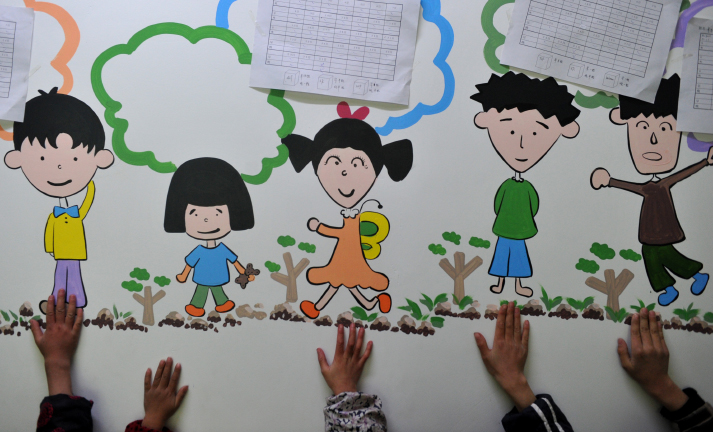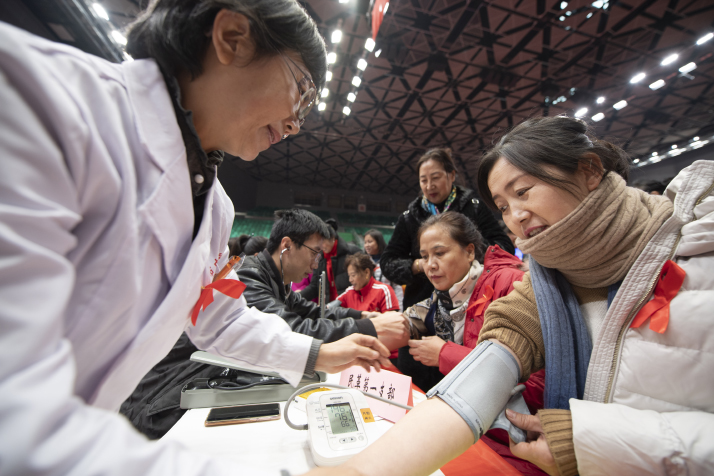| China |
| Aid for HIV/AIDS | |
| Communities play a big role in China's HIV/AIDS awareness efforts | |
|
|
 Cartoon images of Junjun (second from right) and his peers in the AIDS Orphan Salvation Association in Fuyang City of Anhui Province are painted on the wall, on November 30, 2011 (XINHUA)
Junjun (not his real name) is 18 years old and HIV-positive, but unlike many people living with HIV/AIDS in China, he is comfortable in front of the cameras. Born with HIV and orphaned after both his parents died of AIDS in 2004 when he was only 3 years old, Junjun was placed in the AIDS Orphan Salvation Association (AOS) in Fuyang in Anhui Province, east China, the same year. He has lived there ever since. AOS was founded in 2003, as one of the first non-governmental organizations (NGO) in China aimed at helping AIDS orphans. Director Zhang Ying used to be a successful entrepreneur, but after meeting a child who was an AIDS orphan, she changed her career path and looked for ways of helping these children. Junjun arrived one year after the AOS was founded, and the number of children has increased quickly after the year he arrived. The AOS has helped more than 6,000 people. Zhang has received numerous awards for her dedication to children and families affected by HIV/AIDS. Community power Junjun is currently a senior in high school and is going to take the college entrance exam next year. "When he first came to AOS, he was very timid and didn't dare to look at the other kids," Zhang said, "He has now grown into a confident teenager." Junjun, who has an interest in painting, has participated in many exhibitions on HIV/AIDS awareness. "I plan to study animation in college and through my art, I hope to help more people understand HIV/AIDS and promote more caring for people living with HIV/AIDS," he told Xinhua News Agency. The theme of this year's World AIDS Day on December 1 was Community Makes the Difference, which highlighted the significance of social organizations, grassroots medical and health organizations, as well as local resident communities in raising awareness about the disease. Since the first AIDS case was identified in China in June 1985, social organizations and associations have grown, helping to raise awareness and caring for those living with HIV/AIDS. In July 2015, the Chinese Government launched the China AIDS Fund for Non-Governmental Organizations, which has so far allocated about 188 million yuan ($26.8 million) to fund more than 3,500 projects carried out by nearly 1,000 NGOs nationwide. According to the Chinese Center for Disease Control and Prevention (China CDC), the country has basically eliminated HIV transmission through blood transfusions and has effectively contained intravenous drug use and mother-to-child transmission of HIV, which are among the major transmission channels of HIV/AIDS. Currently, the disease is mainly transmitted sexually in China. Men who have sex with men (MSM) accounted for 23.3 percent of all reported cases of HIV infection in 2018, and more than half of new HIV cases among the MSM community were identified through the help of social organizations. Concerted efforts by the government and social groups have led to the rate of HIV infection in the MSM community dropping from 8 percent in 2015 to 6.9 percent in 2018.  Medical staff provide free tests for local residents at an HIV/AIDS awareness event in Taiyuan, capital city of Shanxi Province, on November 29 (XINHUA)
Long way to go "China still faces a great number of challenges in fighting HIV/AIDS, since the prevalence of dating apps has led to more unsafe sexual behavior. Frequent internal migration has also been making effective intervention more difficult," said Zhou Yuhui, Deputy Director of the National Health Commission's (NHC) disease control bureau. Zhou revealed that about a quarter of Chinese people living with the virus are unaware of their HIV-positive status, and a large number of infected people do not receive diagnoses until their condition has developed to an advanced stage. Information from China CDC showed that from January to October, there were 958,000 people known to be HIV-positive. Among them, the number of those at the "two ends," meaning those over the age of 60 and between 15 and 24, showed an increase. For men over 60, the number of new HIV cases has increased from 8,391 in 2012 to 24,465 in 2018. This is due partly to the fact that seniors tend to be less aware of HIV/AIDS prevention and control. Some elderly people exhibit high-risk sexual behavior and quite a few are not aware of how serious AIDS is and seldom voluntarily take an HIV test, making HIV/AIDS prevention and control more difficult. For the group between 15 and 24, China reported a total of 145,000 new cases of HIV/AIDS in 2018. The number of male students affected with HIV/AIDS in colleges has increased in recent years. In Nanchang, capital of the eastern province of Jiangxi, the number of young HIV-positives has increased by over 40 percent year by year in the past five years. Wang Fusheng, an expert in infectious diseases and an academician with the Chinese Academy of Sciences, said the lack of awareness about the disease is one major challenge to controlling its spread. "Survey of about 9,300 young people has shown that fewer than 20 percent of the respondents consider themselves at risk of contracting the virus. But based on risk-evaluation studies, it is estimated that 40 percent are at high risk of being infected with HIV," Wang said. Since 2014, China has launched an annual educational program known as An AIDS-Free Generation to enhance awareness about the prevention and control of HIV among college students. In the following weeks, the program will be carried out at eight colleges in Xi'an in Shaanxi Province, northwest China as well as Beijing, Shanghai and Tianjin. "China has put more emphasis on curbing the spread of HIV infection among its teenagers and young adults in recent years," said Sun Xinhua, Chairman of the Chinese Foundation for Prevention of STD and AIDS, one of the initiators of the program. On November 30, the day before World AIDS Day, the NHC announced six major goals to keep HIV/AIDS prevalence at a low level. The goals include raising awareness of HIV prevention and control, educating people on avoiding or reducing unsafe sexual behavior, detecting and treating as many cases of HIV infection as possible, and eliminating mother-to-child transmission. Premier Li Keqiang said in an guide published on the same day that relevant agencies should use reform of the disease prevention and control system as an opportunity to continue to innovate mechanisms and methods, ensure sound public health services, and focus on key areas and groups. "The effectiveness of education and intervention needs to be improved, monitoring and early warning should be strengthened, and more emphasis should be given to the role of social organizations in AIDS prevention," Li said. Copyedited by Rebeca Toledo Comments to yuanyuan@bjreview.com |
|
||||||||||||||||||||||||||||
|
